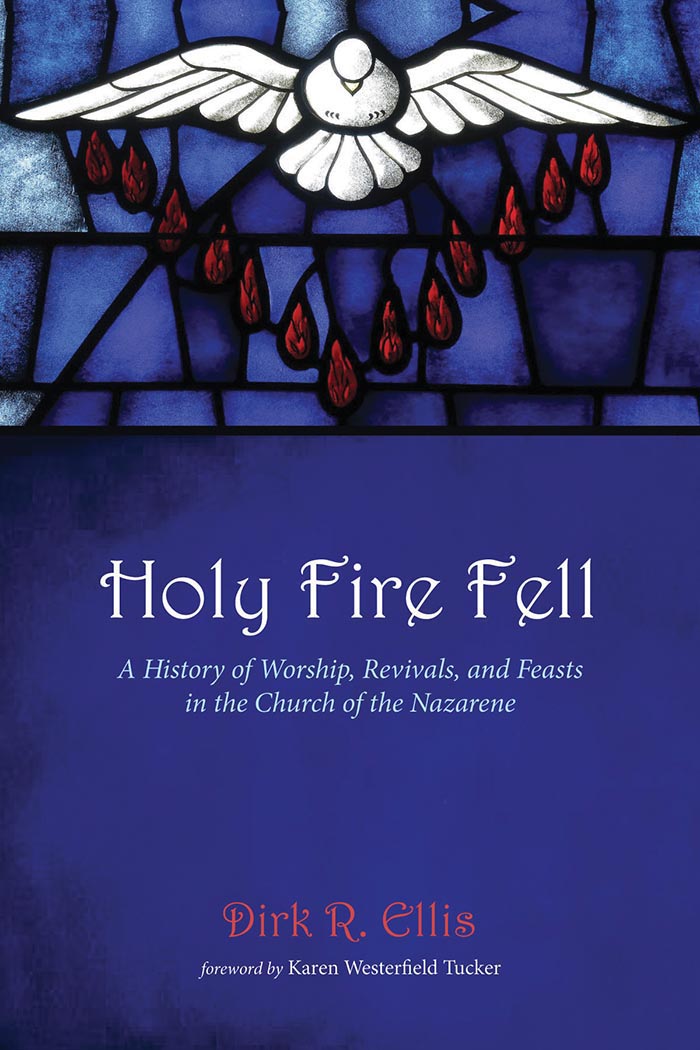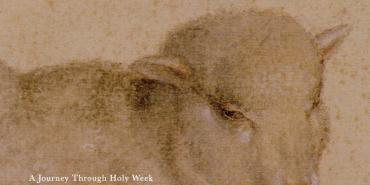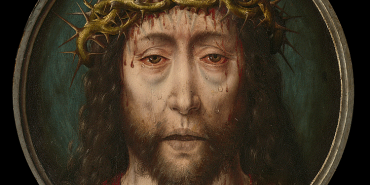Nazarene Worship in Historical Perspective

Holy Fire Fell: A History of Worship, Revivals, and Feasts in the Church of the Nazarene
by Dirk Ellis · (Wipf & Stock, 2016) · 235 pp.
Reviewed by Stan Ingersol
Holy Fire Fell is Dirk Ellis’ engaging study of Nazarene worship. While Ellis is a pastor, he is also a scholar whose new book makes a distinct contribution to Nazarene history, while also contributing to our ongoing discussions about worship—including worship’s purposes, styles, and theological bases. He rightly argues that “retracing [this] history is an important step in assessing the present and planning for the future.”1
The book is richly peopled with such figures as John Wesley, Phineas Bresee, and J. B. Chapman. It bristles with insight as it chronicles and assesses the history and roles of sermons, sacraments, music, and special services in Nazarene life.
Nazarene histories have focused on leaders, institutions, missions, and theology, and yet Nazarene culture is largely centered around worship—the focal point of congregational life in all generations. For a century, worship has connected Nazarenes to God, formed us as Christians, equipped us to be disciples, and prepared us for service.
The Nazarene experience cannot be understood in isolation from worship.
So we should study how the elements and practices of our worship evolved. Many of us have lived through multiple transitions in the art of preaching, sacramental practice, and (especially) church music. We can create a better lens for discerning what in our worship has permanent value and what is merely transient when we understand our worship patterns in their historical development.
Ellis is well-acquainted with his sources, and he proposes a clear thesis that ties his themes together. He argues that major changes in Nazarene worship were shaped by an over-arching shift that occurred in the past thirty years, as Nazarenes moved away from the culture of revivalism in which the church was founded.
Ellis writes: “The structure and content of worship ceased to be shaped by revivalism but instead was determined by the means and methods born out of the church-growth movement.” “Traditional Nazarene patterns,” he argues, “are becoming increasingly extinct.” Some congregations opt for praise music. Others return to Wesleyan roots. Some cling to traditional worship styles.2
At the outset, Nazarenes were birthed by a revival movement tied to the National Camp Meeting Association for the Promotion of Holiness. Camp meeting revivalism shaped the culture of Sunday morning worship, which aimed to be spirited and uplifting; Sunday night services, which tended to be evangelistic; and Wednesday night prayer meeting, where testimonies to victorious living were highly prized. Camp meeting culture influenced Nazarene music and was embodied in the one- and two-week revivals that most congregations once held. It was also embodied in the district camp meeting, which (with district assembly) was once a pillar of district culture.
Ellis examines John Wesley’s worship practices. Wesley’s vision of the holy life found expression by holding together, in tension, both the high church liturgy of Anglicanism and the low church liturgy of the Methodist class and band meetings.
This discussion is important, as today’s younger Wesleyan evangelicals often draw inspiration and strength from Wesley’s eclectic precedents. Wesley also sparks renewed interest in liturgical. Thus, Ellis’ chapter on Wesley holds contemporary value.
Ellis next traces the evolution of worship style in American Methodism. The worship patterns of Nazarene founders were largely shaped by American Methodism. Early Nazarenes embraced Wesley’s doctrine of entire sanctification but abandoned key practices through which Wesley had initiated, encouraged, and supported the sanctified life. Their standard practices grew out different things, like the frontier revival and the summer camp meeting conducted in shady groves—contexts that were foreign to Wesley but emerged as distinct features in New World Methodism, deeply grounded in American geography and culture.
Ellis then offers chapters on a series of topics relating more closely to the Church of the Nazarene itself: the evolving structure and character of Sunday morning worship, the sacraments, and special services like the love-feast, which Bresee carried over from the Methodists.
The discussion of Sunday worship includes extended exposition of the sermon’s role in worship, the place and changing styles of music, the roles of Scripture and creeds, the altar call, the appropriation of national holidays, and the Christian calendar.
When he turns to sacraments, Ellis notes that Bresee, as pastor of Los Angeles First Church from 1895 to 1911, conducted Holy Communion services on Sunday afternoons, not in morning worship. He notes that “reports of worship at Los Angeles First depict experientially robust and meaningful sacramental services.”3 He also found descriptions of joyous Communion services among early Nazarene congregations of the northeastern United States, including the narrative of a man who was converted during such a service.
How often should the Lord’s Supper be administered? The Nazarene Manual has long required that Communion be provided at least each quarter. This was inherited from American Methodism. But as Ellis and others have shown, this was a minimum requirement. Some, like J. B. Chapman, thought the minimum requirement should also be the maximum, but Ellis found early Nazarene congregations that observed the Eucharist monthly. In recent years, a more frequent Communion has become increasingly popular with some pastors and churches.4
Ellis discusses various issues surrounding Christian baptism. Should we choose infant baptism or believers’ baptism? Should it be administered by immersion, pouring, or sprinkling? Should pastors re-baptize someone? These areas of contention are discussed redemptively in the book.
Ellis also offers some pertinent commentary on features that have recently arisen, like applause during worship services. Early Nazarenes would have been astonished at a congregation applauding a musical number or a preacher. And yet, he writes, “today [applause] is one of the most common responses in Nazarene worship.”5
Holy Fire Fell was a very welcome addition to my bookshelf, where it sits beside Karen Westerfield Tucker’s American Methodist Worship. In tandem, these volumes document the origin and development of the worship practices that have characterized Nazarene life for over a century.
1. Ellis, p. 66.
2. Ibid, p. 65.
3. Ibid, p. 150.
4. Ibid, 145-150.
5. Ibid, 141.
Holiness Today, November/December 2017
Holy Fire Fell may be ordered through Wipf and Stock Publishing.
Please note: This article was originally published in 2017. All facts, figures, and titles were accurate to the best of our knowledge at that time but may have since changed.




